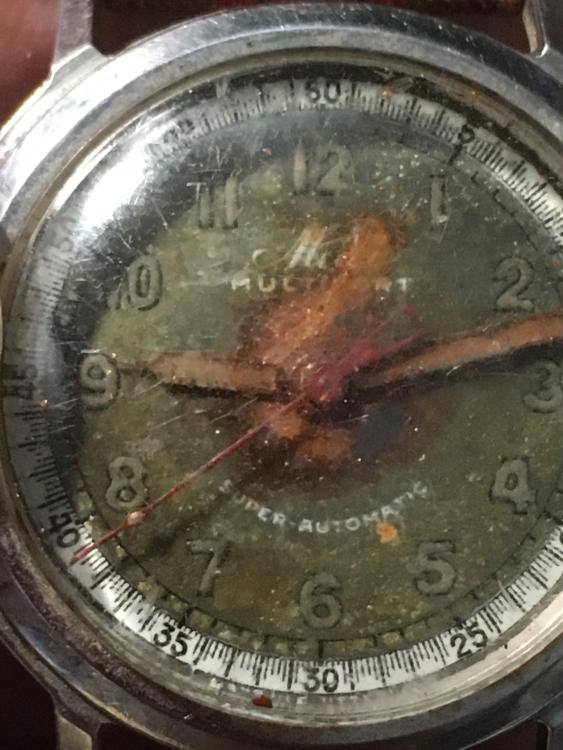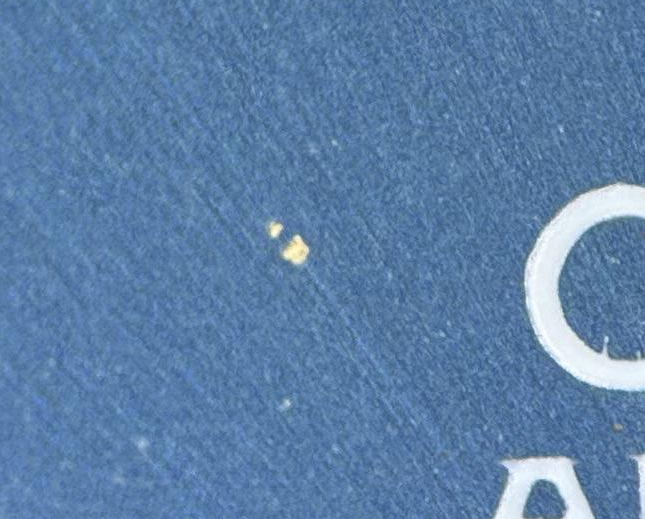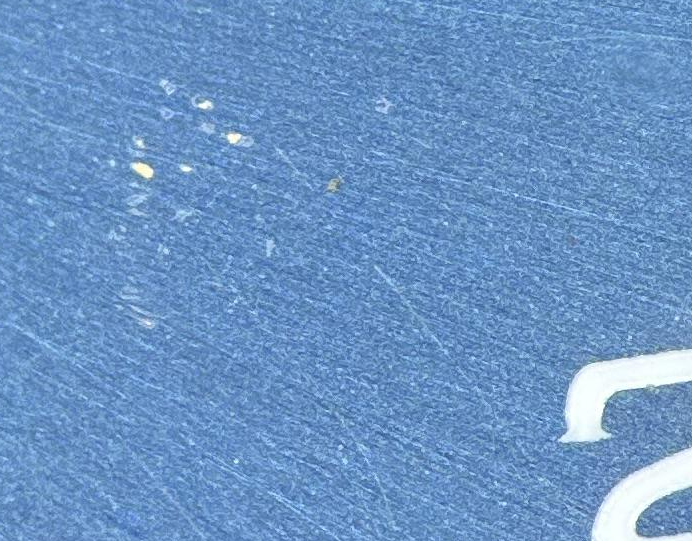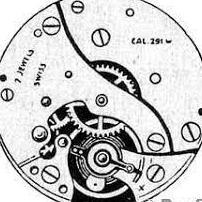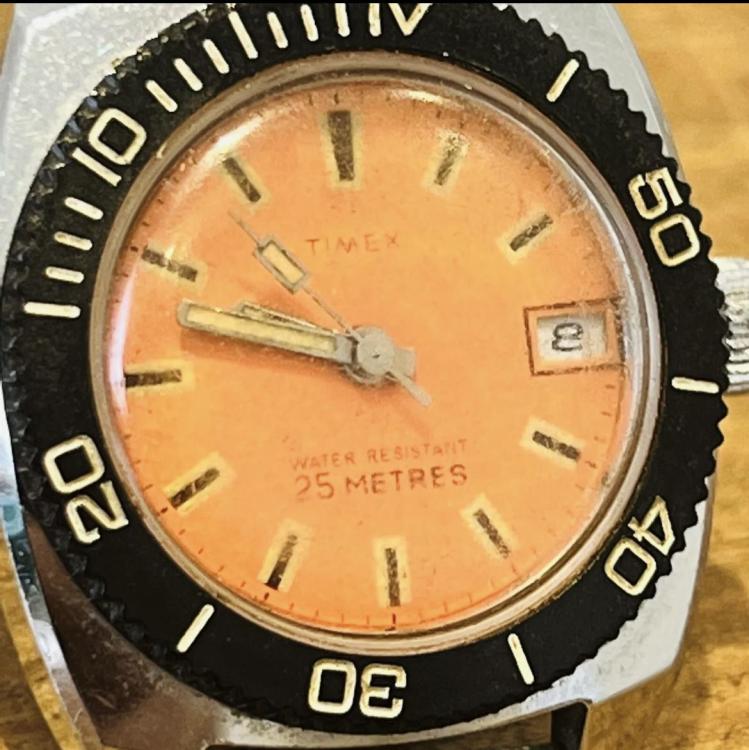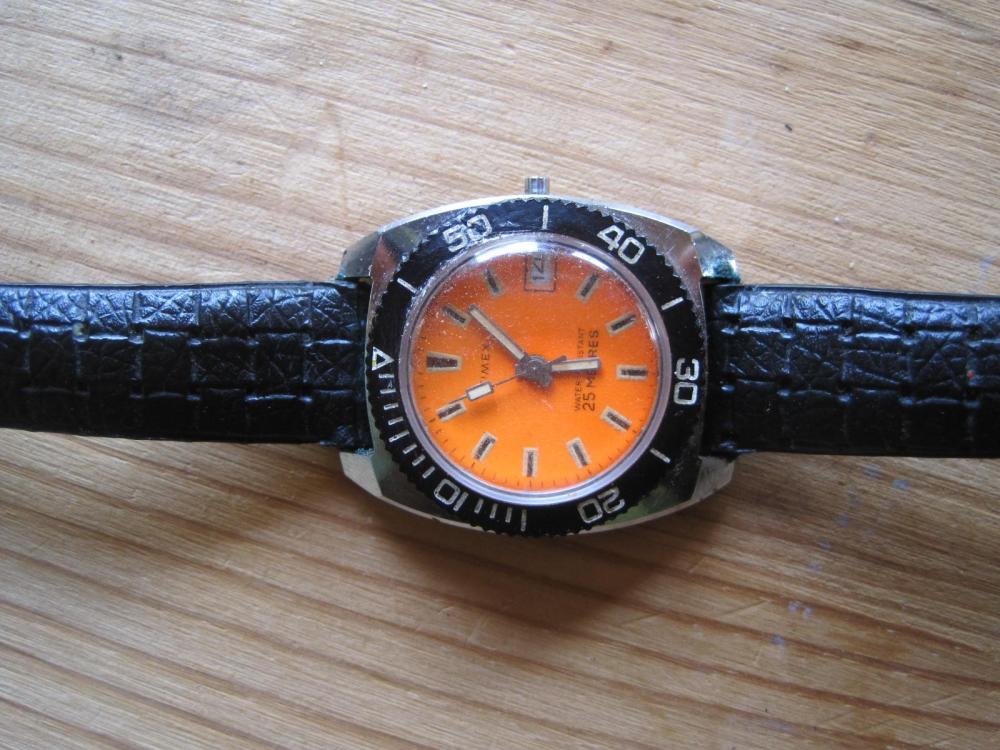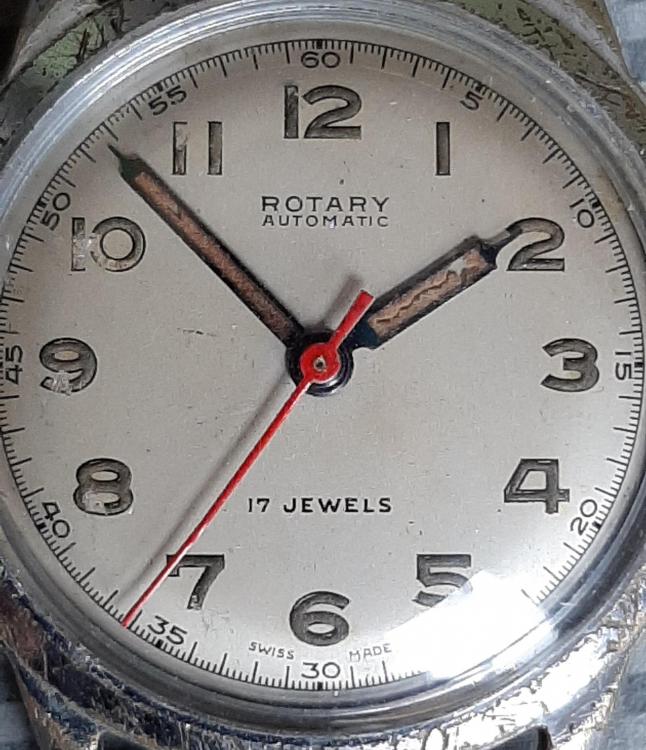Search the Community
Showing results for 'Radium'.
-

Should I be worried about radium?
AndyHull replied to danizzz's topic in Chat About Watches & The Industry Here
I'm posting this here as I think it will be of interest to anyone working with radium dials and watches. I would suggest that there is actually very little measurable risk from handling a few radium watch hands, so long as you wash your own hands afterwards, and make sure that you don't grind up significant amounts of the material and release it in to the air. The point here being that you would need significant amounts. Grams of dust, not a few microgrammes. You have to bear in mind that the materials involved are indeed radioactive, and that they present a hazard, but that hazard is a cumulative one. In other words the radiation they produce would need to be present for a considerable period of time and in significant amounts to produce a measurable statistical risk. In the environment around us at all times, there are similar levels of radioactive materials to the amount you would be encountering in a watch hand. Even the humble banana is very very very slightly radioactive, due to the fact that it is a good source of potassium (which we need for our biological health), some of which is naturally radioactive. We are perfectly capable of dealing with the tiny amount of damage this radiation does. We probably receive far more DNA damage walking around on a nice sunny day in the snow, from ultraviolet light. Our biology is designed to deal with this in the same way that we deal with a cut finger or any other damage. Radiation damage from alpha and beta emitters (like radium) is generally very low level. The harm would come if you treated the stuff the same way the Radium Girls, who painted radium dials for a living did. They absorbed many millions of times more radium than you would ever be exposed to from a few minutes directly handling the radium in a few watch hands. I've posted the chart below a few times, but it is relevant. I would estimate your dose from staying in the room where a few watch hands have been exposed to the elements for a few hours, would not even be measurable. It certainly wouldn't increase background levels by any significant amount. If, for a dare, you were crazy enough to eat the watch hands, you would mainly ingest some steel, some zinc sulphide and a tiny amount of radium. You would excrete the majority of the radium, but a tiny tiny amount of an already tiny amount *might* be absorbed, but you would probably absorb more radioactivity from eating a few bananas. The most dangerous thing about eating them might be from the obvious risk of eating sharp bits of metal. I am obviously not advocating eating watch hands, radioactive or otherwise. If you have already cleaned up the surfaces that might have had a few micrograms of radium on them, then you will be unlikely to be able to measure any increase in background radiation levels. If you were still concerned, then take some measurements with a Geiger counter of the general background radiation elsewhere. In the kitchen for an hour, in the garden for an hour, in your workplace perhaps for an hour, and get a good feeling for what is normal, then re-measure in the area that you are worried about. I would doubt if you can detect anything above background. Even if the area seems to have slightly higher levels than normal, this may still be normal, and may have existed prior to your watch hand work. Take a look at the above chart and you will see that you need significantly higher levels to warrant concern. If you live in Aberdeen for example, or Devon, or anywhere that there is granite in the local geology, then you will naturally be exposed to slightly higher levels of radiation from uranium, radon and other naturally occurring radioactive materials than you would in say Dover which is geologically mainly chalk and limestone. This does not lead to any significant risk. Aberdonians do not grow two heads or glow in the dark as a result. -
Good morning folks: I am looking to have my 1940s Mido wristwatch repaired. I posted previously about it and the radium which is present on the dial. Can someone refer me to an experienced watchmaker, preferably (but not necessarily) in the pacific northwest (USA), whom I could contact about the repair. The watch has little monetary value but high sentimental value. Feel free to post or DM me. Thank you. Arron.
-

To lume or not to lume...
mikepilk replied to rehajm's topic in Your Current Projects and Achievements
Maybe the radium was flaking off the hands and someone plastered the lume on top? I've seen people use lacquer to stabilize radium and prevent flaking. -
Omega Seamaster 176.007
JohnR725 replied to swiss2k's topic in Dial / Hands Cleaning and Restoration
I suppose technically we still need to figure out what the problem is. for instance what exactly is this? the white is printed on but the spots look like they're on top of the surface unless their chips? So there on top of the surface up off of their might remove them or they may make special well basically fancy cotton swabs you maybe would just gently nudge them slowly come off. Providing there actually something on the surface and not in the surface now for these ones it's hard to tell I think all the white stuff is probably something extra what's on top it may just wipe off or blow off but the others spots just can't tell. then those images are a pretty high magnification in the sections I snipped out or even bigger. If the white specks would just go away maybe you'd be happy. Traditionally any form of cleaning cleaning products can have undesirable results on the dial. If you had a spare dial to play with but then a few disparate dial you just swap. So traditionally any form of cleaning painted dials has the potential of making things worse. then we have this. Notice the T stands for Tritium safer than radium but it does present a challenge for someone trying to replace anything that was florescent because ideally they have to use that. I was at a lecture a little while back and is about restoring hands slack she talked about buying hands that use this for the luminescent material salvaging the material in making a new stuff to put on the new hands that they had not recommended for casual use because yes it's still radioactive. the problem is when you're dealing with a painted surface anything you do will probably make it worse unless it's something external like residue left behind from the fluorescent markers if you're lucky oh just blow off. The problem is if the wife is actually a gouge or something filling it in matching the color would be impossible. Anything you do will probably make it worse. But maybe somebody on the discussion group will tell you some thing that I don't know and fix the problem. -
Anyone worried about radium watches should send them to me right away.
-
https://www.mass.gov/service-details/health-effects-of-radium-radiation-exposure Long story short, unless you've been exposed to radium in large amounts or small/medium amounts over long periods of time, the chance of having any adverse health issues are pretty small. Unless you were scratching off the lume and intentionally breathing in the dust, handling a couple of watches without proper dust protection and/or gloves is unlikely to have any impact on you. I highly recommend against anyone doing this and urge anyone dealing with radium to take the proper precautions or just don't work on that movement.
-
Working with de-cased hands and dials containing tritium is less concerning. By the time tritium lume is a teenager it has lost half of its radioactivity. Most of the existing watches with exposed tritium lume (as opposed to those using the isotope sealed in encapsulated glass tubes) are 30-50 years old and have only a small fraction of what they started with. Radium, however, has a half-life of 16 centuries, so it'll be there when we are all gone. It also emits a more penetrating and damaging type of radiation so it deserves a bit more consideration when exposure occurs during repair and restoration.
-
thanks for that information. after posting i set my Geiger counter on it and it was over 1500; which concerns me. Now i'm not so sure how i will handle the restoration. I'll either send it out to someone who works on radium watches or wait until my skill set develops before i try to handle it. For now it will remain entombed in plastic in my workshop. Still looking for more info if anyone has some. thanks.
-

Today's movie tip: Radium Girls
VWatchie replied to VWatchie's topic in Watch or Horology Related Videos
I just Googled this topic and learned that "almost every watch between 1917 and the early 1970s used a form of radium paint", and that "the easiest way to tell if a watch is radioactive is to pick up a simple Geiger counter". However, the article also mentions other ways or hints to determine if a watch uses radium. I didn't realize how dangerous radium is until I read the article and considering that many of the watches we enjoy working on are pre-1970s, I'm going to be more cautious in the future. Here's the article. -
Hand restoration
Geotex replied to Mike78's topic in Restoration Techniques - Polishing, Refinishing, Bluing, Rust, etc..
Radium risks in watch repair are manageable, but realize that actively disturbing the lume layer is the most risky thing you could do. If you go that route rather than sourcing replacement hands that would be acceptable, be sure to work wet so no airborne dust is created. As far as soaking, there are a variety of binders that have been used to lume those old hands, so you might need to do some trials with both polar and non-polar solvents to see what would have an effect. Sometimes old lume seems to lose integrity and falls apart when you do no more than blow on it, but other times it acts as if it has petrified to stone! -
Hey there, Been practising my repair skills and bought this 1973 Timex diver (M25 movement) to play with. The lume was pretty flaky on the hands so I scraped it off quite carelessly but now I'm a bit paranoid about it being radioactive. Hence wondering if someone could help me figure out what type of lume it is? It's definitely from 73 so radium should be out(?). And there's no "t" on the dial, so it might not be tritium, or it might not just have a t. First image is from my watch, the second is actually from this forum where another user was repairing it. My lume was a lot more yellow than his! Any info much appreciated! Thanks,
-
I love the word assume. Because I'm assuming that there was no florescent material at all including the hands. then the Internet I went searching for images I was thinking perhaps I was wrong? I notice these were listed under military watches and that would imply radium typically. If you look at the watches that have radium on the dial's it's quite prominent. Not just prominent but a lot of times the mark the dial so they know where to put the radium. But if there was a radium marking on the dial it seems like there would've been residue which you have none then I was thinking perhaps the hands had something but the dial definitely did not but I found the last example. You'll notice in this example the hands are over the seconds markings and apparently they have transparent radium or no radium at all.
-

Should I be worried about radium?
AndyHull replied to danizzz's topic in Chat About Watches & The Industry Here
Generally watches are "sealed units" in other words, the watch is designed to keep dust, dirt, moisture and so forth out of the watch. For this reason, anything inside the watch will stay in it, and anything outside the watch will stay out. Obviously if you open and service the watch there is the potential for radium dust to escape, but the quantities are miniscule. As various people have mentioned, unless you actually plan on eating the radium hands, then the risk of radiation damage from them is almost immeasurably small. Radium is not something to be messed with, but neither is it likely to harm you if you act sensibly. If you do plan on working with radium based lume or other radioactive lume (tritium etc), then pop on your covid mask and gloves, wash your hands afterwards and don't go grinding up the lume in to dust and you will be fine. The majority of the lume is actually not radium, but a material that emits light when stimulated by alpha or beta radiation. Zinc sulphide powder has been the most widely used luminescent material. Most of the lume is therefore harmless, but since it is bound up with a small quantity of radioactive material (the radium) you need to assume it is all potentially hazardous, even if it is no longer luminous. The level of hazard is low for a single watch. Radium emits Alpha and Beta radiation mainly. The vast majority of the radiation is absorbed by the luminescent material. What does escape from that is absorbed by the case, crystal, dial and so forth. Therefore storing a radium containing watch with other stuff is not a significant problem, so long as the watch case and crystal are intact. Even if they are not, the risk is pretty small. You would probably see similar levels of radiation coming from a granite work top (uranium, radon, etc.), or possibly even from a bunch of bananas (potassium). Don't loose any sleep over it, but equally don't let anyone eat the watch, as that would present a choking hazard. -
Should I be worried about radium?
Fred48 replied to danizzz's topic in Chat About Watches & The Industry Here
As a retired medical radiation physicist, I would be very wary of radium as it's half life is 1600 years (as opposed to tritium which is 12 years), which means it's strength won't diminish in our lifetimes for sure. So, I personally would not wear a radium dial watch 24/7 as it is close to the skin, constantly exposing with alpha, beta, and high energy gamma rays (so sticking radium hands in a typical lead box doesn't really do much), and the radiation level varies from watch to watch. Granted, it's probably small, but is cumulative over time and increases significantly the closer it gets to you. And, as has been previously pointed out, inhalation or ingestion of radium particles is especially bad as now the radium is up close to internal organs like the lungs. Also, proper disposal of radium is tricky as it's effect never diminishes. Companies that dispose of radioactive material as a business have state licenses that they must adhere to; watchmakers? I doubt it. https://www.livescience.com/39623-facts-about-radium.html#:~:text=Radium emits alpha particles (two,according to New World Encyclopedia. -

Radium watch materials
Neverenoughwatches replied to brunomartins's topic in Chat About Watches & The Industry Here
Hi Bruno . I have quite a few watches from the 30s up to the 50s that have radium lume. There are differences of opinions on this subject. Somewhere here is a chart with radioative danger levels of materials we encounter during general living. Radium lume did seem rather low in relation to what is hazardous to us and within certain guidelines of exposure. That being said if incorrectly handled and disturbed risk would be higher. Any dust inhaled and absorption through your skin an obvious danger. The British MOD did change dials to a safer Tritium lume dial on their mil spec. watches after the second world war second as and when they were serviced . It doesnt stop me working on watches with radium but i am extra careful and do wear a face mask as a precaution. The risks though are entirely your decision. People can smoke heavily all through their life without any cancer scares others get away with very little. Some research on the subject will help you decide. -
my understanding is the military radium products are very very bad compared to the civilian. Usually the watchmaking point of view you'll see radium burn on the dial I've never seen it on a crystal. The other place where I see it is the old hand assortments. Hands were mounted on a piece of paper and the radium hands if you move the hand you can see where burn the paper. This even came up the other day somebody asked about it I showed him the hands the radium hands you could see the paper was burned. unfortunately for watch repair, you will see it as I said on dials occasionally the hand assortments if you're still on the paper occasionally. The problem watch repair is things like the hand assortments there's a brand-new hand assortments from whatever it doesn't have a date on it most people wouldn't know the radium unless you knew what to look for. Unless you have a Geiger counter you don't know that that nice assortment a hands that you bought some of them are radium. So unfortunately the radium stuff is still around unless you have a Geiger counter unless it burns the paper a dial or crystal he can't look at him and tell entirely. Then you only see the burn if it stays in one place long enough to burn something.
-
It's true, it could well be radium. I believe Omega switched from radium to tritium (half life: 12.3 years) in 1962. This watch dates to '62, so I will be cautious. It is crumbling anyway, so it has to go. I will leave the dots on the dial untouched.
-
There is nothing to worry about. If you did all that cleaning there is probably no radium left. Even if some did fall off somewhere you didn't get to, the amount of radon gas it would produce would almost certainly be negligible. If it would put your mind at ease, you could get one of those radon gas test kits. However, with the small amounts of radium you were dealing with, I really don't think it is necessary.
-
How what we apply a different rule here? An observation that I've made has been when you find somebody this concerned are upset with something then usually that's going to be bad for them. It probably won't be bad for the rest of us but you probably will die from cancer from radiation exposure. It's just your destiny so knowing that it's your destiny don't play with them. I just noticed over the years of my life that things that people get upset about are the things that plagued them in life so this is going to be your thing then get your Geiger counter and stay away from them. Then while you're at it takers sensitive Geiger counter and look at the videos on that channel of all the other stuff is radioactive some of that vintage glass that you might have in the kitchen or certain ceramics that have certain colors on them East shows a ceramic tile but in one of his videos in the antique story was running around in there all kinds of things are radioactive. Then a course you go back farther and they're all kinds a silly people at thought radioactive stuff was good for you all sorts of Healthy remedies of that new angle radium stuff. Then unfortunately there's another YouTube channel or two that I subscribed to that talks about disasters and is back in water disasters of and it's not from radium watch hands. Usually some of the biggest disasters involves medical stuff either by accidental computer programming or the real big one is medical waste ending up in places where they don't grasp what the pretty powder is inside spread all over the place. There has been several really sizable disasters of that because the other problem of course is you can't see it So the rule is if it's going to bother you get rid of it.
-

Should I be worried about radium?
mikepilk replied to danizzz's topic in Chat About Watches & The Industry Here
I bought a 50s Rotary with radium hands/dial - pinging nicely on the Geiger counter Most of the radium is in the hands - which I will replace (taking all necessary precautions), but I'm not sure what to do with the dial. Should I leave it as is (with radiation probably not much higher than that of background), or remove it ? The radium on the numbers should come off with water, hopefully not damaging the dial, leaving the black number outlines. I could just leave it at that, or try and replace the lume, which looks difficult. I have a similar looking Universal Geneve : On that I replaced the hand lume, but left the dial as original. But as this is a cheapish watch I'm thinking it might be better to risk removing all the radium, then it's safer to wear and I can sell it as a non-radium watch. (BTW I bought it because it was cheap and an old ETA 1256 movement, which I haven't seen before. I will re-plate that case!) -
I would just dab the dial gently with Rodico. Those "red dots" will be radium - take the recommended care should-i-be-worried-about-radium Basically it's flaking radium you want to avoid, so I would keep the dial in a sealed plastic bag. Once you get a glass fitted it will be OK.
-
I never regularly worked on radium dials. Maybe maximum two. Thanks for the reassurance. @mikepilk. Thanks for your comment as well. I unfortunately don't see too many hobbiest watchmakers talk about the dangers of radium. It's important to look out for the little guys. Those who are just starting out and don't know what to look for. We tell a lot of new watchmakers to practice on vintage watches (which is a good way to practice), but vintage watches can obviously be a bit dangerous when in the wrong hands, especially when learning to relume. Just a unsettling invisible danger. Thanks for the info guys
-

Radium watch worries
Neverenoughwatches replied to MattyG's topic in Identify This Movement or Watch
Prolonged and consistent exposure to radium would cause health issues matty. You will be fine dont worry, unless you were working on radium dial watches on a regular basis and being very careless. Just take precautions in the future.



